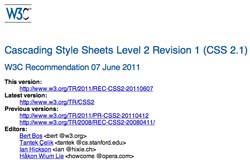It's official: W3C finalises CSS 2.1
Milestones still important, argue standards advocates

Cascading Style Sheets Level 2 Revision 1 (CSS 2.1) Specification (or CSS 2.1 to its friends) has become a real boy, with W3C stamping its seal of approval and making the spec a W3C Recommendation. But in an age of rapidly iterating browsers that are already working hard to win the race regarding CSS3 compatibility, is the W3C now an anachronism? Standards advocates don’t seem to think so.
Eric Meyer, partner and co-founder of An Event Apart says that while the formalisation of CSS 2.1 has been a “long, twisty road”, he’s happy we’ve finally reached its end: “It's important because CSS 2.1 is a specification that describes, as best it can, what's done in practice as opposed to what might be nice in theory”. Meyer argues that it’s a good idea from time to time to document how things work, “both for implementors who come to the game later and authors who want to understand how CSS works”.
Easy! Designs, LLC principal and author of Adaptive Web Design Aaron Gustafson agrees that specs remain relevant in a world of rapid iteration: “At first, I was against the movement of the WHATWG away from a versioned spec because I was concerned the W3C would follow suit. I came to realise, however, that what was happening was a separation that was mutually beneficial: the WHATWG could work on charting the course for the future while the W3C worked on placing the milestones along that course”.
Gustafson argues milestones remain important, for seeing how web languages have evolved and for testing the conformance of browsers and authored documents. “Without them, you’ve no ability to see if you're doing something correctly or not,” he says.
A consistent approach
Web designer Lynne Pope also argues that milestone specifications remain essential to ensure the web doesn’t become fragmented. “Draft specs let us know what is intended and having the proposals out in the open, being able to follow changes, means we don't get any sudden surprises. As we can see with HTML (5, that is) and CSS3, browsers are implementing different features in different ways. Currently, the only way to get close to reasonable cross-browser HTML (5) support is by using JavaScript to compensate for inadequacies”.
Pope says that once standards become a recommendation, everyone knows browser developers have comprehensively tested their code and been reasonably satisfied that they can reach compliance with them: “100 per cent compliance doesn't always happen, but without the browser and application vendors working together to agree a standard cross-browser, design work would become intolerable”.
Looking to the future
With the CSS 2.1 chapter now closed, it’s also certain that the consistency Pope yearns for regarding CSS3 will be a major focus for browser developers, but she also notes that it’s essentially been 13 years since the previous recommendation (CSS 2, in May 1998). However, it’s unlikely that CSS3 will suffer the same fate.
Get the Creative Bloq Newsletter
Daily design news, reviews, how-tos and more, as picked by the editors.
“I’ll predict that CSS 2.1 is last CSS standard to take so many years to develop,” thinks designer, author and speaker Andy Clarke. “Instead, we’ll see CSS3 features implemented in browsers, CSS modules created, worked on and finalised in months, not years”.
Gustafson agrees: “What’s important to realise about the spec process is that a given spec does not become a recommendation until there are at least two interoperable implementations of each feature. With really large specs, it’s difficult to attain that. That's one of the reasons CSS3 is broken into modules. That way each module can move at its own pace as opposed to slowing down the development of future specs.”

Thank you for reading 5 articles this month* Join now for unlimited access
Enjoy your first month for just £1 / $1 / €1
*Read 5 free articles per month without a subscription

Join now for unlimited access
Try first month for just £1 / $1 / €1

The Creative Bloq team is made up of a group of art and design enthusiasts, and has changed and evolved since Creative Bloq began back in 2012. The current website team consists of eight full-time members of staff: Editor Georgia Coggan, Deputy Editor Rosie Hilder, Ecommerce Editor Beren Neale, Senior News Editor Daniel Piper, Editor, Digital Art and 3D Ian Dean, Tech Reviews Editor Erlingur Einarsson, Ecommerce Writer Beth Nicholls and Staff Writer Natalie Fear, as well as a roster of freelancers from around the world. The ImagineFX magazine team also pitch in, ensuring that content from leading digital art publication ImagineFX is represented on Creative Bloq.
